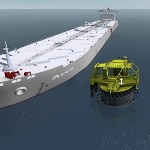VSTEP Training & Distribution Partnership
 VSTEP has announced a distribution and training partnership with Centro de Investigación y Entrenamiento Marítimo y Fluvial (CIEMF) a training business unit of Servicio Integral de Prácticos S.A. (SIPSA) in Buenos Aires, Argentina. CIEMF was the first customer in Latin America to implement the NAUTIS simulation software on its Full Mission Bridge Simulator. CIEMF is VSTEP’s first Latin American training partner.
VSTEP has announced a distribution and training partnership with Centro de Investigación y Entrenamiento Marítimo y Fluvial (CIEMF) a training business unit of Servicio Integral de Prácticos S.A. (SIPSA) in Buenos Aires, Argentina. CIEMF was the first customer in Latin America to implement the NAUTIS simulation software on its Full Mission Bridge Simulator. CIEMF is VSTEP’s first Latin American training partner.
Latin America is a region experiencing rapid economic growth and looking to innovative solutions to maintain its impressive rate of growth. With focus on highly realistic yet cost effective solutions, the VSTEP simulators are a perfect fit in the region. CIEMF, located in the heart of Buenos Aires, Argentina, is a pioneer in the use of this innovative technology, using its high-end simulator to train maritime professionals across Latin America.. In the time ahead, it will become a pinnacle player in helping others adopt these innovative simulator solutions throughout the continent.
Experienced
VSTEP VP Business Development, Capt Mark Woolley, US Navy ret: “The real value of maritime simulators lies in the experience of the instructors, who are able to create a superior learning environment for students. CIEMF is a highly experienced maritime training provider. Its decision to use Nautis simulation software is a sign of the powerful benefits this new generation of simulation technology can bring, in the hands of experienced instructors. We are working closely with CIEMF to further develop the simulation software to meet their expectations. CIEMF’s experience in this process is invaluable.”
First Choice
SIPSA/CIEMF CTO, Alberto Secchi: “NAUTIS was our first choice for maritime simulation training. It allows for realistic simulation of sailing maneuvers, docking, mooring to buoys, use of ropes and tugs, all sorts of failures and events, and different hydro meteorological and visibility conditions, daytime with good and bad visibility and nighttime. It allows for recording of maneuvers that are carried out so we can extract the respective technical conclusions through a very detailed analysis.”






